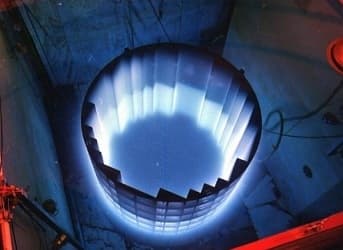Tri-Alpha Energy has allowed a bit of its research out into the world with a 79 page pdf document rich in background, results of the efforts early research, and a surprise about how the potential fuel, Boron (pB11) would react in a fusion reaction. Hat tip to Brian Wang’s Next Big Future.
Tri-Alpha’s position is, “We want to know the energy and location of every outgoing alpha particle.” This is important because in a pB11 reaction the harvest is high energy Helium that can be used to directly generate electricity.
The news from Tri-Alpha is the discovery of two high-energy α-particles (alphas) – that will have a huge impact on pB11 fueled reactor designs because the alphas are much easier to extract and convert more efficiently into electricity.
This is quite significant news and powerful information that may apply to the other two leading pB11 fueled efforts, the Lerner Focus Fusion effort and the Bussard Wiffle Ball work.

Tri-Alpha Early Reactor Artist’s Rendering.
At Tri-Alpha the work hinges on whether or not the reaction confinement will work at levels need to trigger the reaction. The whole idea as with the others is to capture enough of the containment and collected energy as fission/fusion by-products.
Why “fission/fusion” or more like “fusion/fission” you might ask . . .
The function in the fusion is a proton is driven into a boron atom making it a carbon atom in a very highly energized state. The new carbon atom is proton/neutron unbalanced making it inherently unstable and so flies apart. Actually the carbon atom can’t last long, it’s quite excited what with nucleons, quarks and other subatomic particles way over energized it simply comes apart, fissions, into helium atoms that also hold extreme energies that can be shed into electrical circuits.
What’s left is a new boron, missing some of its nucleus and unstable it too flies apart into lower energy helium as well.
Dr. Lerner, leader of the Focus Fusion effort straightens this out with, “I think to the vast majority of nuclear physicists, fission is a process produced by the interaction of neutrons—neutral particles—and nuclei, while fusion is a process produced by the interaction of charged nuclei with each other. The names, like many names in physics and elsewhere, have historical origins . . . Since pB11 is produced by the interactions of charged nuclei, everyone would call it fusion, even though the final nuclei are smaller than one of the initial nuclei.”
Note that the difference is in the nuclear reaction – fusion takes an energy input from the proton and fission responds to the neutron.
The pB11 in fusion idea has been around over 75 years with three primary particles. Not long after the two alpha idea was confirmed. Over the decades experimenters and theoreticians accepted the two alpha scenario with one high energy and one low energy.
But Tri-Alpha has a huge advantage with the march of technology adding up to today. The better equipment plus Tri-Alpha’s research questions found a much better answer.
Everyone interested in power from fusion has to know what Tri-Alpha is asking – what is the absolute number of alphas?
The Tri-Alpha answer is one primary alpha from the first incidence with the proton and two more from the carbon atom when it’s reduced back to a Boron 8.
Back in 1933 Lord Rutherford thought was that 3 equal alphas would result. In 1936 with 300 keV power Dee and Gilbert found 2 highly energized alphas and a third low energy one. Tri-Alpha is up to 0.675 MeV power and confirms Dee and Gilbert – although not quite as expected.
The news is based on a much more thorough understanding of what takes place. Tri-Alpha, and now everyone else, can see a boron fusion yields a quick high-energy alpha and the boron 8 that also has a high-energy alpha.
That recheck of the physics is causing a redesign of the Tri-Alpha reactor.
The news may well cause a rethink at Lerner’s Focus Fusion and perhaps even at the Bussard Wiffle Ball effort. There’s more power in that pB11 fuel than everyone has been thinking. Except for perhaps Dr. Robert Bussard.
By. Brian Westenhaus
Source: Tri-Alpha Energy Comes Out With Boron Fuel News



















C12 is balanced.
"What’s left is a new boron, missing some of its nucleus and unstable it too flies apart into lower energy helium as well."
That's impossible! What's left is Be8.
"The Tri-Alpha answer is one primary alpha from the first incidence with the proton and two more from the carbon atom when it’s reduced back to a Boron 8."
Beryllium 8